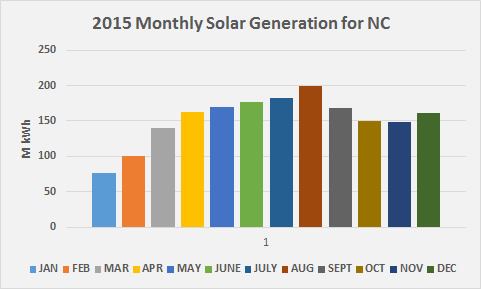 | ||
Solar power in North Carolina has been increasing rapidly, from less than 1 MW in 2007 to nearly 470 MW in 2013, and in 2015 had the fourth largest installed capacity of the US states. Declining panel costs, a 30 percent federal grant known as a 1603 grant, available through December 31, 2011, and a 30 percent tax credit available through 2019, declining to 10% by 2022. The federal tax credit is in addition to any local incentives, and pays for the cost of installation, which can be rolled over if less taxes are owed that year. The difference between a tax deduction and a tax credit is substantial, as a deduction depends on your tax rate to determine your savings, but a tax credit is directly available to repay the cost of installation. A 2012 estimate indicates that a typical 5 kW solar array will pay for itself in 6 years, and thereafter generate a substantial profit.
Contents
- Generation
- 2014 Duke Energy initiative
- 2015 Completions Future
- Completed Projects
- Under Construction
- References
In addition to federal incentives, the state has a Renewable Portfolio Standard of 12.5% by 2021 and a state renewable energy tax credit, both of which have been credited with boosting solar installations.
SunEdison has built a 17.2 megawatt solar farm in Davidson County. Other prominent solar contractors in North Carolina include Strata Solar, Baker Renewable Energy and FLS Energy.
Source: NRELGeneration
Using data mined from US Energy Information Agency Electric Power Annual 2014 and Electric Power Monthly Data Browser the following table summarizes North Carolina’s solar energy posture.
Capacity factor for each year was computed from the end of year summer capacity for 2014/2015 and is low. 2015 data is from Electric Power Monthly and is subject to change.
Beginning with the 2014 data year, Energy Information Administration will estimate distributed solar photovoltaic generation and distributed solar photovoltaic capacity. These non-utility scale estimates project that, in 2014 North Carolina, generated a further 72 GWh and in 2015 an additional 90 GWh of solar electricity from such distributed PV systems.
2014 Duke Energy initiative
On September 15, 2014 Duke Energy committed $500 million to an expansion of solar power in North Carolina.
2015 Completions & Future
On September 9, 2015, Duke Energy Renewables announced the completion of four solar farms with combined output totaling 30 MW, in addition to three other farms under construction. The three farms under construction, once completed will have an output totaling 132 MW.
Completed Projects
Under Construction
As of September 9, 2015
